#Eastern Arabian Peninsula
Text
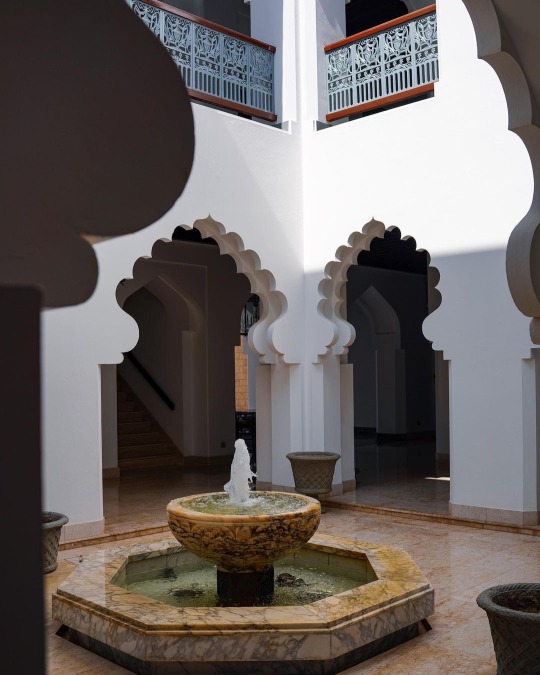
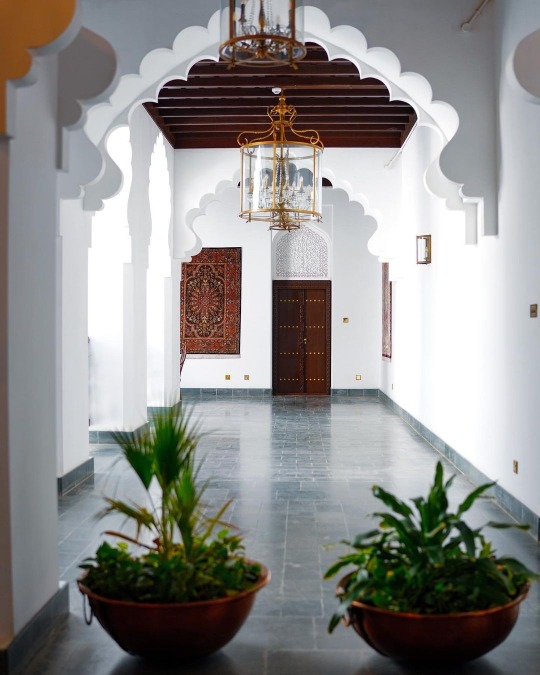
Bayt Greiza | بيت جريزة
Built in 1597 in an urban complex in Muscat, Sultanate of Oman (Eastern Arabia) which included the Portuguese governor’s residence, a factory, a garrison, and a church, which is called “Gariza” in Portuguese, from which the palace’s name is derived.
The palace combines local Arab and Portuguese architecture. 🇴🇲🇵🇹
#arab#arabian#culture#interior#middle east#interior design#architecture#oman#sultanate of Oman#omani architecture#🇴🇲#عمان#سلطنة عمان#Portugal#🇵🇹#Portuguese architecture#arab architecture#arabian peninsula#Khaleeji#arabian Gulf#history#arab interior#Portuguese interior#MENA#east Arabia#Eastern Arabia#الخليج#الخليج العربي#courtyards
8 notes
·
View notes
Text
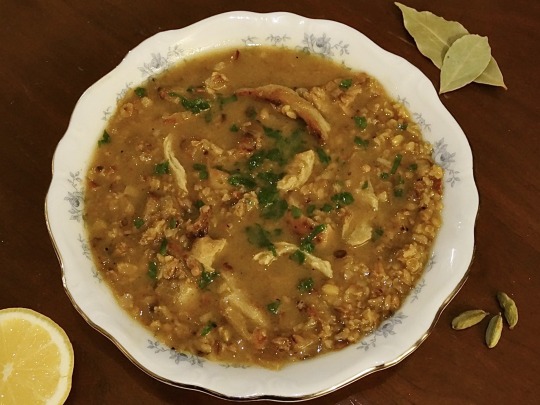

[ID: A greenish-brown soup with an herb garnish in a bowl surrounded by a halved lemon, green cardamom pods, and bay leaves, followed by a close-up of the same soup. End ID]
شوربة الفريكة / Shorabat al-frika (Green wheat soup)
Frika (فَرِيكَة or فَرِيك; also transliterated "freekeh," "frikeh," or "farik") is durum wheat harvested in the early spring, while the grain is green, unripe, and tender. Durum wheat, or semolina, is a different species of wheat than that which is ground to produce all-purpose flour (common wheat, or bread wheat); it is used to make couscous (كُسْكُس), bulghur (بلغور), and many types of pasta, and is widely consumed in North Africa, the Levant, and the Arabian peninsula. After harvest, unripe durum is sun-dried and then set ablaze in piles to burn off the straw and leave just the heads of wheat, resulting in a nutty, smoky flavor; the heads are then vigorously rubbed, traditionally by hand, to remove the bran. Frika is named after this last process; the word comes from the verb "فَرَكَ" "faraka," "to rub."
A staple in Palestine, shorabat al-frika (with diacritics, Levantine pronunciation: شُورَبَة الفْرِيكَة) is often eaten as an appetizer with the fast-breaking meal during Ramadan. It may contain nothing more than an onion, olive oil, frika, and water, but sometimes contains meat (usually chicken, but also beef or lamb), green chili peppers, and spices including cardamom, black pepper, bay leaves, turmeric, cumin, and seb'a baharat; some people today like to add chickpeas. Shorabat al-frika is often prepared with the chicken broth obtained by boiling chicken to make musakhkhan (مُسَخَّن), and served alongside it. It is a warming, filling, and earthy soup, with a complexity of flavor imparted by the frika itself: a fresh tartness due to the unripe grain, and a roasted aroma due to its harvesting process.
Shorabat al-frika is in keeping with a Palestinian food ethos of using simple, local ingredients to their fullest potential. Frika itself is sometimes thought to symbolize adaptability and resilience, as it was often eaten in times of scarcity when other crops were not yet ready to be harvested. Legend holds that it was discovered in a time of similar necessity: when villagers in the eastern Mediterannean tried to salvage a field of wheat that had been burned by ambushing soldiers, they found that the grain was still edible beneath the blackened chaff, having been saved from the fire by its moisture.
Frika, due to its centuries as a staple in Palestine, has also come to symbolize acceptance, Palestinian history, and connection to the land and community. In the Palestinian diaspora and amongst internally displaced people in Palestine, food is conceived of as a form of connection to homeland across distance; continuing to make Palestinian food, and remembering or using baladi ("native," "from my country") varieties of grains, produce, and herbs, is a link to the land and an expression of the hope to return.
By the same token, though, frika has come to represent Palestinian displacement and "cultural obliteration," per Rana Abdulla. One of the ways in which Israel rhetorically justifies its existence is by claiming sole ownership of an old, organically arising culture rooted in the land: the easiest way to do this is, of course, to rebrand what was already there. Food connects and combines language (in terminology and pronunciation), culture, history, climate, and land into one web of discourses, and is therefore a prime site for colonial myth-making and ideological nation-building. Thus a construction such as "Israeli freekeh" is, in fact, an intensely political one.
Nevertheless, frika continues its life as a symbol of connection, community, and resistance during adversity in Palestine. Nasser Abufarha, of the Palestine Fair Trade Association, noted in 2015 that more and more Palestinians across the West Bank were harvesting some of their wheat early to make frika, rather than relying on cheaper, imported rice. As of October 23 2023, and in defiance of an Israeli air raid which destroyed their kitchen in 2014, Jamil Abu Assi and his cousins were using frika, alongside lentils and rice, as staples in distributing food to thousands of refugees per day in Bani Suhaila, near Khan Younis. Others in the community donated ingredients or volunteered to distribute meals.
Support Palestinian resistance by contributing to Palestine Action's bail fund or to Palestine Legal's defence fund, or by attending court or making a sign to support the Elbit Eight.
Ingredients:
1 cup (170g) frika baladia (فريكة بلدية), Levantine frika
4 cups water, or vegetarian chicken stock from concentrate
1 large yellow onion, chopped
1/4 cup extra virgin olive oil
1 green chili pepper (فلفل أخضر حار), sliced (optional)
1/2 tsp ground black pepper (فلفل اسود)
5 cardamom pods (حب هال)
2 Mediterannean bay leaves (ورق غار)
250g chicken (or beef) substitute, torn or cubed (optional)
Salt, to taste
Parsley, to garnish
Halved lemon, to serve (optional)
I have kept the spices relatively simple, as most cooks do, to highlight the earthy end of the taste spectrum and to allow the flavor of the frika itself to come forward. Most people add at least cardamom and black pepper; many add bay leaves to this duo; turmeric is the next most common addition I have come across. I have seen a few people add cumin, coriander, or allspice.
Frika can be found in the grains section of your local halal grocery store (labelled "فريكة", “فريك" "freekeh" or "frikeh"). Look for something that specifies “roasted.”
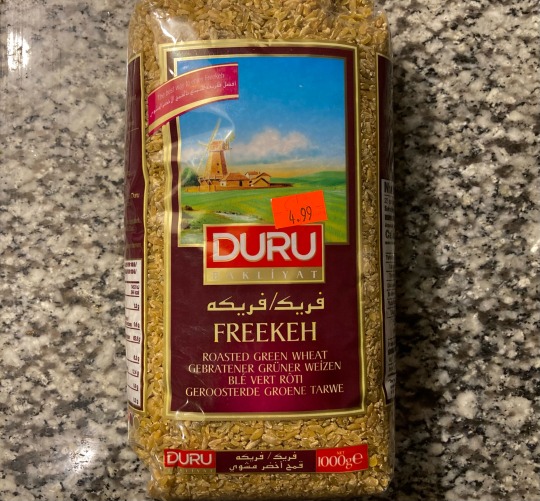
You may also be able to find frika at a speciality or health foods grocery store, but it might not have been fire-roasted as it is in the Levant. If your frika doesn't smell toasty, try roasting it in a dry pan on medium-heat for a few minutes until fragrant.
Frika may be found whole, cracked, or fine (نَاعِمَة / na'ima). You may use any kind for this soup; most people use cracked or fine frika, because of its shorter cooking time. You can pulse whole frika a few times in a food processor or spice mill, until coarsely ground, if you prefer a fine texture but can't find fine frika.

Instructions:
1. Heat olive oil in a large pot on medium. Add onion, a pinch of salt, cardamom pods, and bay leaves and fry, stirring occasionally, until the onion is golden brown.
2. Add the chili pepper and cook briefly until softened.
3. Add frika and black pepper and roast, stirring occasionally, for a few minutes until fragrant.
4. Add the water or stock and stir to combine. Bring to a fast simmer and cook, covered, about 50 minutes for whole frika and 20 minutes for ground, until fully cooked. Add additional water as necessary. The frika will still be chewy at the end of the cooking time.
5. Fry meat substitute of your choice in olive oil with salt, black pepper, and a optionally a pinch of Palestinian seven-spice, until browned. Add to soup and stir to combine. Taste the soup and add salt and more black pepper, if necessary.
6. Garnish with whole or chopped parsley and serve warm.
The meat is usually added to this soup just after the onions, and simmered along with the frika. You can do it this way if you like, but I have never found simmering to do the texture of meat substitutes any favors.
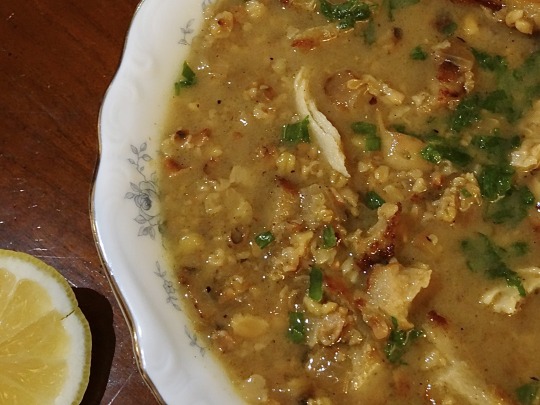
492 notes
·
View notes
Text
tips for writing arab characters
writer here!! im a middle eastern writer whos noticed that theres a VERY significant lack of info on how to write arabs, so im here to help !! (however, keep in mind that im specifically gulf arab and may not be able to provide as much info on levant arabs or north african arabs. if there are any on here, feel free to reblog w more info !! )
dont get arabs mixed up w muslims. yes, a large portion of the arab population are muslim, but youd be surprised at the number of non-muslim arabs that exist. if you wanna write abt a muslim character, a post i made that might help is here
list of arab countries, with the adjective:
algeria — algerian
bahrain — bahraini
the comoros islands — comorans
djibouti — djiboutian
egypt — egyptian
iraq — iraqi
jordan — jordanian
kuwait — kuwaiti
lebanon — lebanese
libya — libyan
morocco — moroccan
mauritania — mauritanian
oman — omani
palestine — palestinian
qatar — qatari
kingdom of saudi arabia (ksa) — saudi
somalia — somali
sudan — sudanese
syria — syrian
tunisia — tunisian
united arab emirates (uae) — emirati
yemen — yemeni
dialects/language:
dialects greatly differ—the egyptian dialect is the most common, followed closely by the levantine dialect
classic arabic is called fusha (fuss-ha), used in things like official documents, media, education. every arab knows it but its not used in day to day language except in media (all dialects basically come from fusha, but with slight changes)
'p' and 'g' (as in 'gurgle' or 'goal') dont exist in the arabic alphabet, theyre replaced with 'b' and 'j'
depending on where theyre from, they may also learn a third language besides arabic and english (e.g. moroccans know french, a berber arab may know berber)
appearance:
arabs look different based on where theyre from. if theyre from the arabian peninsula, they have thick curly dark hair, tanned skin, and dark eyes. levant arabs are lighter skinned, and green/blue eyes are more common with them
adding on to previous point, arabs have a variety of skin tones, even if theyre siblings. using a real example, me and my older brother respectively look white passing and afro hispanic
dark irises are considered better looking than lighter colored eyes. eyes are usually thick-lashed, with big round slightly upturned eyes
big noses are common, along with full lips (and hereditary dark circles for those with more tanned skin)
high cheekbones and well structured faces are also prevalent
culture:
varies depending on location
influenced by indian culture, IS NOT INTERCHANGEABLE WITH INDIAN CULTURE. that was aladdins mistake
poetry is so common, especially with romantic themes
songs also have romantic themes
youd be surprised at how romantic arabs are
dances vary extremely, from dabke (palestinean dance done in groups, consisting largely of leg/foot movements) to yola (emirati dance with battle origins, done using canes or fake guns) i recommend watching videos (tiktok has a lot of videos esp of dabke)
women also dance but you wont find a lot of videos of it bc its inappropriate
etiquette:
things such as giving someone your back, or facing the bottom of your feet towards someone are considered rude
pda is also taboo (even with straight couples or even sometimes married couples)
cheek kisses are a common way of greeting, but not between genders
in some gulf countries, men greet each other with a nose kiss (not in an intimate way) just stubbing their noses against each other
genders do not mix at all. schools tend to divide girls and boys into two sections starting at a certain age (around age 10/11), and mosques are split into the mens side (usually larger than womens bc men use the mosque more)
having an extramarital relationship is very very taboo (even w hetero relationships) but it still happens. a lot.
family dynamics (note that this is obviously a spectrum. this is the general dynamic, but obv it ranges from family to family):
NOT ALL OF US HAVE ABUSIVE PARENTS. sure theyll spank you if you skip school, but thats not necessarily abusive. its more strict, and youd be surprised at the amount of freedom some parents give their kids
yes, arranged marriages do happen. no, they arent necessarily forced, it just means that your parents had a hand in deciding who youll marry. yes, marrying cousins is a thing, but its much less prevalent now (also, ew)
fathers care. a lot. they dont show it, but they do. they also tend to joke around a lot
mothers tend to be the rule enforcers, and by far our moms are our best friends. we tell them EVERYTHING i swear
aunties gossip a lot
uncles are a safety hazard
its not uncommon to have a large number of cousins (mainly bc arabs tend to have a lot of kids)
the average number of children 3 per woman, but from personal experience the older the generation the more kids (e.g. my great-grandmother had a whopping thirteen kids, my grandmother had seven, my mom has six, but a couple of my aunts only have one or two)
social class/work environment/school environment:
schools tend to be either arab curriculums but there is a high density of american/british curriculum schools
boys and girls tend to be separated in school around age nine/ten but some schools will be mixed genders up till graduation
yes, women work, tho admittedly some of them tend to have careers more than jobs (e.g. photographer, writer, etc while the men handle engineering, economics, etc)
no, not all of us are rich. in fact, countries like jordan, egypt, tunisia, morocco, and yemen (and infamously palestine) are acc struggling w poverty. its mainly just gulf arabs who are rich
furthermore, gulf arabs may be generally rich but a large chunk of them have the same lifestyle as an upper-middle class family in the usa. rich but not too rich. dont be fooled by the videos of guys wearing kandoras and driving lambos
speaking of kandoras...
outfits (keep in mind that spelling may vary since its all transliteration, and pronunciation may vary depending on region) (also keep in mind that even if we still live in the middle east, WE CAN WEAR JEANS AND HOODIES AND BAND SHIRTS. just, usually cover up more in public):
abaya: loose overgarment worn by women
jilbab/chandoor: also worn by women, type of long dress or tunic
the white robe all of yall know is known as a thobe, dishdasha, or kandora
the colored headscarf worn by men is known as a ghuthrain in the gulf, kevfiah in the levant. its kept in place with a black cord called a aghal, and under it they wear a skullcap called a thagiyah
those are the most common ones, however if youd like to get a lil more specific on clothong, the ultimate guide to arab clothing is here (it also has specified clothing for individual countries)
hope this helps, feel free to reblog w more info if you have any !!
#writing tips#writing arabs#arab#writer sources#writing help#writers on tumblr#writeblr#writing advice
100 notes
·
View notes
Text

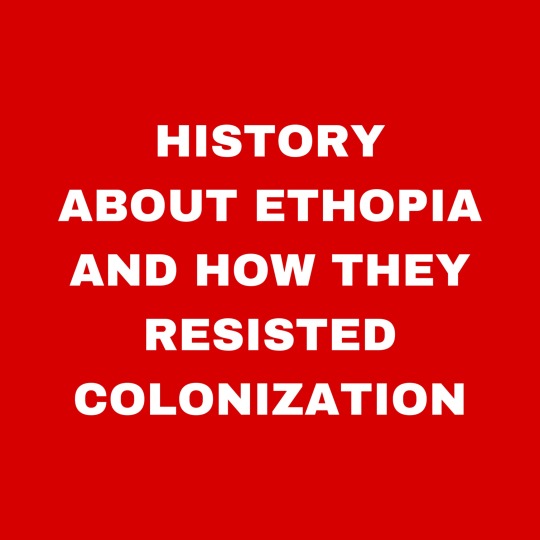
This is a message to my black brothers and sisters
Learn about your history
Ethiopia is one of the oldest countries in Africa; the emergence of Ethiopian civilization dates back thousands of years. Abyssinia or rather "Ze Etiyopia" was ruled by the Semitic Abyssinians (Habesha) composed mainly of the Amhara and Tigray, the Cushitic Agaw. In the Eastern escarpment of the Ethiopian highlands and more so the lowlands was the home of the Arab-descended Harari that founded Sultanates such as Ifat and Adal and the Afars. In the central and south were found the ancient Sidama and Semitic Gurage, among otheres. One of the first kingdoms to rise to power in the territory was the kingdom of D'mt in the 10th century BC, which established its capital at Yeha. In the first century AD the Aksumite Kingdom rose to power in the modern Tigray Region with its capital at Aksum and grew into a major power on the Red Sea, subjugating South Arabia and Meroe and its surrounding areas. In the early fourth century, during the reign of Ezana, Christianity was declared the state religion. Ezana's reign is also when the Aksumites first identified themselves as "Ethiopians", and not long after, Philostorgius became the first foreign author to call the Aksumites Ethiopians.[The Aksumite empire fell into decline with the rise of Islam in the Arabian peninsula, which slowly shifted trade away from the Christian Aksum.[citation needed] It eventually became isolated, its economy slumped and Aksum's commercial domination of the region ended.The Aksumites gave way to the Zagwe dynasty, who established a new capital at Lalibela before giving way to the Solomonic dynasty in the 13th century. During the early Solomonic period, Ethiopia went through military reforms and imperial expansion that allowed it to dominate the Horn of Africa.
How did Ethiopia Resist Imperialism?
Ethiopia, formerly Abyssinia, is one of the world’s oldest countries. Dating to around 400 BCE, the region is documented in the in the King James Version of the Bible as the Kingdom of Axum. Along with Rome, Persia, and China, Axum was considered one of the four great powers of the era. Throughout the millennia of its history, the willingness of the country’s people—from farmers to kings—to come together as one, coupled with its geographic isolation and economic prosperity, helped Ethiopia score decisive victories against a series of global colonialist forces.
Ethiopia is considered “never colonized” by some scholars, despite Italy's occupation from 1936–1941 because it did not result in a lasting colonial administration.
Seeking to expand its already considerable colonial empire in Africa, Italy invaded Ethiopia in 1895. In the ensuing First Italo-Ethiopian War (1895-1896), Ethiopian troops won a crushing victory over Italian forces at the Battle of Adwa on March 1, 1896. On October 23, 1896, Italy agreed to the Treaty of Addis Ababa, ending the war and recognizing Ethiopia as an independent state.
On Oct. 3, 1935, Italian dictator Benito Mussolini, hoping to rebuild his nation’s prestige lost in the Battle of Adwa, ordered a second invasion of Ethiopia. On May 9, 1936, Italy succeeded in annexing Ethiopia. On June 1 of that year, the country was merged with Eritrea and Italian Somalia to form Africa Orientale Italiana (AOI or Italian East Africa).
Ethiopian Emperor Haile Selassie made an impassioned appeal for assistance in removing the Italians and re-establishing independence to the League of Nations on June 30, 1936, gaining support from the U.S. and Russia. But many League of Nations members, including Britain and France, recognized Italian colonization.
It was not until May 5, 1941, when Selassie was restored to the Ethiopian throne, that independence was regained.
Ethiopia's ability to resist being swept up in the "Scramble for Africa" can be credited to the stability of its longstanding imperial government, beginning with the Abyssinian Empire in the 13th century, and lasting into the late 20th century, with the exception of a brief Italian occupation during the 1930s. King Menelik II, the Emperor during the period of rampant European exploration and colonization in Africa, was careful to cultivate an alliance with the smaller surrounding kingdoms of North Africa, and with European powers including Italy and Russia. When Italy began to turn the sights of their imperial ambitions toward Ethiopia, the Ethiopian military became the only African kingdom able to successfully resist the military might of European colonial power, using Russian-supplied weapons to defeat the Italian invading force at the Battle of Adwa in 1896. In the aftermath of the battle, in exchange for permanent recognition as an independent empire, Menelik II granted Italy the right to claim the neighboring territory of Eritrea under their imperial umbrella.
Ethiopians have a history of taming lions.
Many Emperors kept pet lions including Halie Selassie. Occasionally visitors like Kwame Nkrumah could pet one of the lions!
This practice of keeping lions is said to date back thousands of years to the Axumite period.The descendants of the Royal Lions currently live in the Addis Ababa zoo.
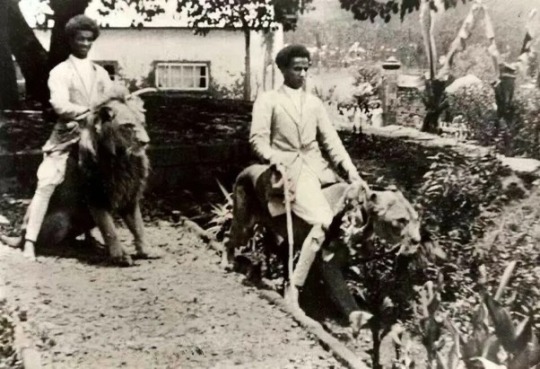
Meet his imperial majesty, the King of the Jungle.
And if, with his thick, shaggy mane Challa seems to have something of a frisky regal air about him - it's because he knows that he is a genuine blue blood.Challa is a direct descendant of Mochuria and Mollua - royal lions, which the late Emperor Haile Selassie kept as pets. The Emperor's practice of keeping pet lions is said to date thousands of years back to the Axumite period.Years ago in Ethiopia, Lions were pets to the people, some were used like donkeys, some like dogs kept at home. Emperor Haile Selassie of Ethiopia had lions he kept as pets, while some Ethiopians could even ride on them. These were not wild lions, they grew up with humans and became domesticated.They didn't go after human blood or other animals, lions roamed around the streets of Ethiopia and live was beautiful with them. Ethiopia is in East Africa, it's a rugged, landlocked country split by the Great Rift Valley, Ethiopia is a place of ancient culture, they believe and still hold on to ancient affairs.
Any lion that goes wild was immediately hunted killed, they were only killed if they kill a human and not animals like goats and chickens. They forbid killing and eating of any lion because lions were pets used in different palaces.
Ethiopia as a country had its origin in about 980 B.C., which makes it one of the oldest nations in the world.
Due to this very long history and an unmatched diversity of people and cultures, the country has often been described as a “museum of peoples”. With such a highly diverse population, Ethiopia houses an intricate tapestry of language and ethnic groups.
Also nicknamed the “Land of 13 Sunshine’s”, Ethiopia is often described as one of the most enthralling and enchanting places in the world – and definitely in Africa.
Ethiopia may not be the first place any traveller think of when planning or booking a next holiday, but it may just as well soon be the case. As African country Ethiopia can boast about having been at peace for at least the previous 15 years or more years and its economy is consequently one of the fastest growing in the world.
With the added bonus of an astounding diversity of landscapes, mixture of cultures and history that tracks back to when homo sapiens first started to raise itself up onto two legs, a traveller suddenly may look forward to a surprising and breath-taking travel destination.
But talking about planning and holiday dated, you probably didn’t know that this unique nation even has its own calendar?
This is but one of a myriad fascinating facts about the country, of which a number are discussed in this article. Looking at the country’s ancient and statutory history, its religion, culture, people and natural phenomena, here are at least 44 random but fascinating facts that you can ponder in anticipation of a visit to this eastern African country in the near future:
Fact number 1 – The oldest people in the world probably lived here.
Fact number 2 – Ethiopia is the oldest independent country in Africa and the only African country that could evade colonial rule.
Fact number 3 – Ethiopia was one of the first African forces to achieve a significant victory over a European colonial power.
Fact number 4 – Ethiopia has a rich history of rulers, including emperors and queens.
Fact number 5 – Ethiopia is perceived to be the diplomatic capital of the African continent
Fact number 6 – Ethiopia is the country with the second highest population in Africa, and with almost 1,5 % of the world population.
Fact number 8 – Ethiopia has the most orphans in the world.
Fact number 10 – Addis Ababa is the highest capital city in Africa.
Fact number 11 – More than 200 dialects are spoken by the peoples of the country.
Please like and share so others can see, drop your comments below and let me know what you think.
98 notes
·
View notes
Text
Countries that are no more: Achaemenid Empire (550BC-330BC)
It was not the first empire of Iranian peoples, but it arose as probably the greatest in terms of influence and became the measure by which all subsequent Iranian empires tended to compare themselves and its influence on culture, government & civil infrastructure would influence others beyond the span of its territory and the span of time. This is the Achaemenid Empire.
Name: In Old Persian it was known as Xšāça or the "The Kingdom or the Empire", it was named the Achaemenid Empire by later historians. Named after the ruling dynasty established by its founder Cyrus the Great who cited the name of his ancestor Haxāmaniš or Achaemenes in Greek as progenitor of the dynasty. It is sometimes also referred to as the First Persian Empire. The Greeks simply referred to it as Persia, the name which stuck for the geographic area of the Iranian plateau well into the modern era.
Language: Old Persian & Aramaic were the official languages. With Old Persian being an Iranian language that was the dynastic language of the Achaemenid ruling dynasty and the language of the Persians, an Iranian people who settled in what is now the southwestern Iranian plateau or southwest Iran circa 1,000 BC. Aramaic was a Semitic language that was the common and administrative language of the prior Neo-Assyrian & Neo-Babylonian Empires which centered in Mesopotamia or modern Iraq, Syria & Anatolian Turkey. After the Persian conquest of Babylon, the use of Aramaic remained the common tongue within the Mesopotamian regions of the empire, eventually becoming a lingua franca across the land. As the empire spread over a vast area and became increasingly multiethnic & multicultural, it absorbed many other languages among its subject peoples. These included the Semitic languages Akkadian, Phoenician & Hebrew. The Iranian language of Median among other regional Iranian languages (Sogdian, Bactrian etc). Various Anatolian languages, Elamite, Thracian & Greek among others.
Territory: 5.5 million kilometers squared or 2.1 million square miles at its peak circa 500BC. The Achaemenid Empire spanned from southern Europe in the Balkans (Greece, Bulgaria, European Turkey) & northwest Africa (Egypt, Libya & Sudan) in the west to its eastern stretches in the Indus Valley (Pakistan) to parts of Central Asia in the northeast. It was centered firstly in the Iranian Plateau (Iran) but also held capitals in Mesopotamia (Iraq). Territory was also found in parts of the Arabian Peninsula & the Caucausus Mountains.
Symbols & Mottos: The Shahbaz or Derafsh Shahbaz was used as the standard of Cyrus the Great, founder of the empire. It depicts a bird of prey, typically believed to be a falcon or hawk (occasionally an eagle) sometimes rendered gold against a red backdrop and depicts the bird holding two orbs in its talons and adorned with an orb likewise above its head. The symbolism was meant to depict the bird guiding the Iranian peoples to conquest and to showcase aggression & strength coupled with dignity. The imperial family often kept falcons for the pastime of falconry.
Religion: The ancient Iranian religion of Zoroastrianism served as the official religion of the empire. It was adopted among the Persian elite & and had its unique beliefs but also helped introduce the concept of free-will among its believers, an idea to influence Judaism, Christianity & Islam in later centuries. Despite this official religion, there was a tolerance for local practices within the subject regions of the empire. The ancient Mesopotamian religion in Babylon & Assyria, Judaism, the Ancient Greek & Egyptian religions & Vedic Hinduism in India was likewise tolerated as well. The tolerance of the Achaemenids was considered a relative hallmark of their dynasty from the start. Famously, in the Old Testament of the Bible it was said that it was Cyrus the Great who freed the Jews from their Babylonian captivity and allowed them to return to their homeland of Judea in modern Israel.
Currency: Gold & silver or bimetallic use of coins became standard within the empire. The gold coins were later referred to as daric and silver as siglos. The main monetary production changes came during the rule of Darius I (522BC-486BC). Originally, they had followed the Lydian practice out of Anatolia of producing coins with gold, but the practice was simplified & refined under the Achaemenids.
Population: The estimates vary ranging from a low end of 17 million to 35 million people on the upper end circa 500BC. The official numbers are hard to determine with certainty but are generally accepted in the tens of millions with the aforementioned 17-35 million being the most reasonable range based on available sources.
Government: The government of the Achaemenid Empire was a hereditary monarchy ruled by a king or shah or later referred to as the ShahanShah or King of Kings, this is roughly equivalent to later use of the term Emperor. Achaemenid rulers due the unprecedented size of their empire held a host of titles which varied overtime but included: King of Kings, Great King, King of Persia, King of Babylon, Pharaoh of Egypt, King of the World, King of the Universe or King of Countries. Cyrus the Great founded the dynasty with his conquest first of the Median Empire and subsequently the Neo-Babylonians and Lydians. He established four different capitals from which to rule: Pasargadae as his first in Persia (southwest central Iran), Ecbatana taken from the Medians in western Iran's Zagros Mountains. The other two capitals being Susa in southwest Iran near and Babylon in modern Iraq which was taken from the Neo-Babylonians. Later Persepolis was made a ceremonial capital too. The ShahanShah or King of Kings was also coupled with the concept of divine rule or the divinity of kings, a concept that was to prove influential in other territories for centuries to come.
While ultimate authority resided with the King of Kings and their bureaucracy could be at times fairly centralized. There was an expansive regional bureaucracy that had a degree of autonomy under the satrapy system. The satraps were the regional governors in service to the King of Kings. The Median Empire had satraps before the Persians but used local kings they conquered as client kings. The Persians did not allow this because of the divine reverence for their ShahanShah. Cyrus the Great established governors as non-royal viceroys on his behalf, though in practice they could rule like kings in all but name for their respective regions. Their administration was over their respective region which varied overtime from 26 to 36 under Darius I. Satraps collected taxes, acted as head over local leaders and bureaucracy, served as supreme judge in their region to settle disputes and criminal cases. They also had to protect the road & postal system established by the King of Kings from bandits and rebels. A council of Persians were sent to assist the satrap with administration, but locals (non-Persian) could likewise be admitted these councils. To ensure loyalty to the ShahanShah, royal secretaries & emissaries were sent as well to support & report back the condition of each satrapy. The so called "eye of the king" made annual inspections of the satrapy to ensure its good condition met the King of Kings' expectations.
Generals in chief were originally made separate to the satrap to divide the civil and military spheres of government & were responsible for military recruitment but in time if central authority from the ShahanShah waned, these could be fused into one with the satrap and general in chiefs becoming hereditary positions.
To convey messages across the widespread road system built within the empire, including the impressive 2,700 km Royal Road which spanned from Susa in Iran to Sardis in Western Anatolia, the angarium (Greek word) were an institution of royal messengers mounted on horseback to ride to the reaches of the empire conveying postage. They were exclusively loyal to the King of Kings. It is said a message could be reached to anywhere within the empire within 15 days to the empire's vast system of relay stations, passing message from rider to rider along its main roads.
Military: The military of the Achaemenids consisted of mostly land based forces: infantry & cavalry but did also eventually include a navy.
Its most famous unit was the 10,000-man strong Immortals. The Immortals were used as elite heavy infantry were ornately dressed. They were said to be constantly as 10,000 men because for any man killed, he was immediately replaced. Armed with shields, scale armor and with a variety of weapons from short spears to swords, daggers, slings, bows & arrows.
The sparabara were the first line of infantry armed with shields and spears. These served as the backbone of the army. Forming shield walls to defend the Persian archers. They were said to ably handle most opponents and could stop enemy arrows though their shields were vulnerable to enemy spears.
There was also the takabara light infantry and though is little known of them it seems they served as garrison troops and skirmishers akin to the Greek peltast of the age.
The cavalry consisted of four distinct groups: chariot driven archers used to shoot down and break up enemy formations, ideally on flat grounds. There was also the traditional horse mounted cavalry and also camel mounted cavalry, both served the traditional cavalry functions and fielded a mix of armor and weapons. Finally, there was the use of war elephants which were brought in from India on the empire's eastern reaches. These provided archers and a massive way to physically & psychologically break opposing forces.
The navy was utilized upon the empire's reaching the Mediterranean and engaged in both battles at sea and for troop transport to areas where troops needing deploying overseas, namely in Greece.
The ethnic composition of Achaemenid military was quite varied ranging from a Persian core with other Iranian peoples such as the Medians, Sogdian, Bactrians and Scythians joining at various times. Others including Anatolians, Assyrians, Babylonians, Anatolians, Indians, Arabs, Jews, Phoenicians, Thracians, Egyptians, Ethiopians, Libyans & Greeks among others.
Their opponents ranged from the various peoples they conquered starting with the Persian conquest of the Medians to the Neo-Babylonians, Lydians, Thracians, Greeks, Egyptians, Arabs & Indians and various others. A hallmark of the empire was to allow the local traditions of subjugated areas to persist so long as garrisons were maintained, taxes were collected, local forces provided levies to the military in times of war, and they did not rebel against the central authority.
Economy: Because of the efficient and extensive road system within the vast empire, trade flourished in a way not yet seen in the varied regions it encompassed. Tax districts were established with the satrapies and could be collected with relative efficiency. Commodities such as gold & jewels from India to the grains of the Nile River valley in Egypt & the dyes of the Phoenicians passed throughout the realm's reaches. Tariffs on trade & agricultural produce provided revenue for the state.
Lifespan: The empire was founded by Cyrus the Great circa 550BC with his eventual conquest of the Median & Lydian Empires. He started out as Cyrus II, King of Persia a client kingdom of the Median Empire. His reign starting in 559BC. Having overthrown and overtaken the Medians, he turned his attention Lydia and the rest of Anatolia (Asia Minor). He later attacked the Eastern Iranian peoples in Bactria, Sogdia and others. He also crossed the Hindu Kush mountains and attacked the Indus Valley getting tribute from various cities.
Cyrus then turned his attention to the west by dealing with the Neo-Babylonian Empire. Following his victory in 539BC at the Battle of Opis, the Persians conquered the Babylonia with relative quickness.
By the time of Cyrus's death his empire had the largest recorded in world history up to that point spanning from Anatolia to the Indus.
Cyrus was succeeded by his sons Cambyses II and Bardiya. Bardiya was replaced by his distant cousin Darius I also known as Darius the Great, whose lineage would constitute a number of the subsequent King of Kings.
Darius faced many rebellions which he put down in succession. His reign is marked by changes to the currency and the largest territorial expansion of the empire. An empire at its absolute zenith. He conquered large swaths of Egypt, the Indus Valley, European Scythia, Thrace & Greece. He also had exploration of the Indian Ocean from the Indus River to Suez Egypt undertaken.
The Greek kingdom of Macedon in the north reaches of the Hellenic world voluntarily became a vassal of Persia in order to avoid destruction. This would prove to be a fateful first contact with this polity that would in time unite the Greek-speaking world in the conquest of the Achaemenid Empire. However, at the time of Darius I's the reign, there were no early indications of this course of events as Macedon was considered even by other Greek states a relative backwater.
Nevertheless, the Battle of Marathon in 490BC halted the conquest of mainland Greece for a decade and showed a check on Persia's power in ways not yet seen. It is also regarded as preserving Classical Greek civilization and is celebrated to this day as an important in the annals of Western civilization more broadly given Classical Greece & in particular Athens's influence on western culture and values.
Xerxes I, son of Darius I vowed to conquer Greece and lead a subsequent invasion in 480BC-479BC. Xerxes originally saw the submission of northern Greece including Macedon but was delayed by the Greeks at the Battle of Thermopylae, most famously by Spartan King Leonidas and his small troop (the famed 300). Though the Persians won the battle it was regarded as a costly victory and one that inspired the Greeks to further resistance. Though Athens was sacked & burnt by the Persians, the subsequent victories on sea & land at Salamis & Plataea drove the Persians back from control over Greece. Though war would rage on until 449BC with the expulsion of the Persians from Europe by the Greeks.
However, the Greeks found themselves in a civil war between Athens & Sparta and Persia having resented the Athenian led coalition against their rule which had expelled them from Europe sought to indirectly weaken the Greeks by supporting Greek factions opposed to Athens through political & financial support.
Following this reversal of fortune abroad, the Achaemenid Empire not able to regain its foothold in Europe, turned inward and focused more on its cultural development. Zoroastrianism became the de-facto official religion of the empire. Additionally, architectural achievements and improvements in its many capitals were undertaken which displayed the empire's wealth. Artaxerxes II who reigned from 405BC-358BC had the longest reign of any Achaemenid ruler and it was characterized by relative peace and stability, though he contended with a number of rebellions including the Great Satraps Revolt of 366BC-360BC which took place in Anatolia and Armenia. Though he was successful in putting down the revolt. He also found himself at war with the Spartans and began to sponsor the Athenians and others against them, showcasing the ever dynamic and changing Greco-Persian relations of the time.
Partially for safety reasons, Persepolis was once again made the capital under Artaxerxes II. He helped expand the city and create many of its monuments.
Artaxerxes III feared the satraps could no longer be trusted in western Asia and ordered their armies disbanded. He faced a campaign against them which suffered some initial defeats before overcoming these rebellions, some leaders of which sought asylum in the Kingom of Macedon under its ruler Philip II (father of Alexander the Great).
Meanwhile, Egypt had effectively become independent from central Achaemenid rule and Artaxerxes III reinvaded in around 340BC-339BC. He faced stiff resistance at times but overcame the Egyptians and the last native Egyptian Pharaoh Nectanebo II was driven from power. From that time on ancient Egypt would be ruled by foreigners who held the title Pharaoh.
Artaxerxes III also faced rebellion from the Phoenicians and originally was ejected from the area of modern coastal Lebanon, Syria & Israel but came back with a large army subsequently reconquered the area including burning the Phoenician city of Sidon down which killed thousands.
Following Artaxerxes III's death his son succeeded him but a case of political intrigue & dynastic murder followed. Eventually Darius III a distant relation within the dynasty took the throne in 336BC hoping to give his reign an element of stability.
Meanwhile in Greece, due to the military reforms and innovations of Philip II, King of Macedon, the Greek speaking world was now unified under Macedon's hegemony. With Philip II holding the title of Hegemon of the Hellenic League, a relatively unified coalition of Greek kingdoms and city-states under Macedon premiership that formed to eventually invade Persia. However, Philip was murdered before his planned invasion of Asia Minor (the Achaemenid's westernmost territory) could commence. His son Alexander III (Alexander the Great) took his father's reforms and consolidated his hold over Greece before crossing over to Anatolia himself.
Darius III had just finished reconquering some rebelling vestiges of Egypt when Alexander army crossed over into Asia Minor circa 334BC. Over the course of 10 years Alexander's major project unfolded, the Macedonian conquest of the Persian Empire. He famously defeated Persians at Granicus, Issus and Gaugamela. The latter two battles against Darius III in person. He took the King of Kings family hostage but treated them well while Darius evacuated to the far eastern reaches of his empire to evade capture. He was subsequently killed by one of his relatives & satraps Bessus, whom Alexander eventually had killed. Bessus had declared himself King of Kings though this wasn't widely recognized and most historians regard Darius III, the last legitimate ShahanShah of Achaemenids.
Alexander had taken Babylon, Susa & Persepolis by 330BC and effectively himself was now ruler of the Persian Empire or at least its western half. In addition to being King of Macedon & Hegemon of the Hellenic League, he gained the titles King of Persia, Pharaoh of Egypt & Lord of Asia. Alexander would in time eventually subdue the eastern portions of the Achaemenid realm including parts of the Indus Valley before turning back to Persia and Babylon where he subsequently became ill and died in June 323BC at age 32. Alexander's intentions it appears were never to replace the Achaemenid government & cultural structure, in fact he planned to maintain and hybridize it with his native Greek culture. He was in fact an admirer of Cyrus the Great (even restoring his tomb after looting) & adopted many Persian customs and dress. He even allowed the Persians to practice their religion and had Persian and Greeks start to serve together in his army. Following his death and with no established successor meant the empire he established which essentially was the whole Achaemenid Empire's territory in addition to the Hellenic world fragmented into different areas run by his most trusted generals who established their own dynasties. The Asian territories from Anatolia to the Indus (including Iran and Mesopotamia) gave way to the Hellenic ruled Seleucid Empire while Egypt became the Hellenic ruled Ptolemaic Kingdom. The synthesis of Persian and Greek cultures continued in the Seleucid and Greco-Bactrian kingdoms of antiquity.
The Achaemenid Empire lasted for a little over two centuries (550BC-330BC) but it casted a long shadow over history. Its influence on Iran alone has persisted into the modern age with every subsequent Persian Empire claiming to be its rightful successor from the Parthian & Sasanian Empires of pre-Islamic Iran to the Safavids of the 16th-18th century and the usage of the title Shah until the last Shah's ejection from power in the 1979 Islamic Revolution. Even the modern Islamic Republic of Iran uses Achaemenid imagery in some military regiments and plays up its importance in tourism and museums as a source of pride to Persian (Farsi) & indeed Iranian heritage. Likewise, its form of governance and the pushing of the concept of divine rights of kings would transplant from its Greek conquerors into the rest of Europe along with various other institutions such as its road & mail system, tax collection & flourishing trade. Its mix of centralized & decentralized governance. Its religious & cultural tolerance of local regions even after their conquest would likewise serve as a template for other empires throughout history too. The Achaemenid Empire served as a template for vast international & transcontinental empires that would follow in its wake & surpass its size & scope of influence. However, it is worth studying for in its time, it was unprecedented, and its innovations so admired by the likes of Alexander the Great and others echo into the modern era.
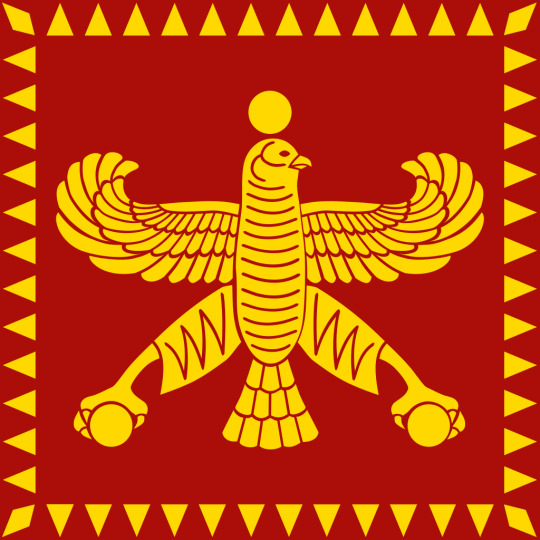
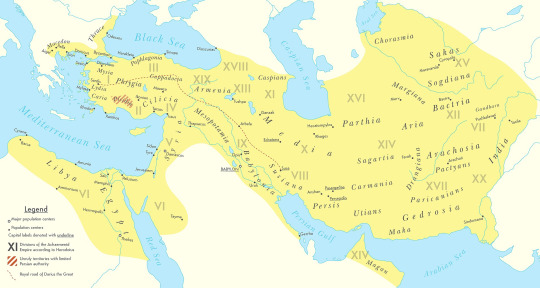


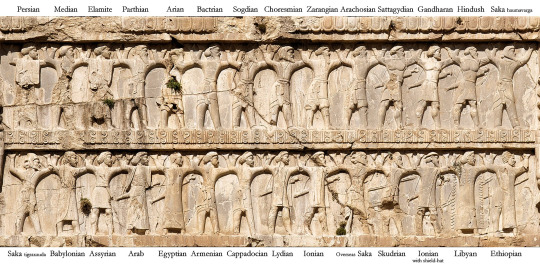
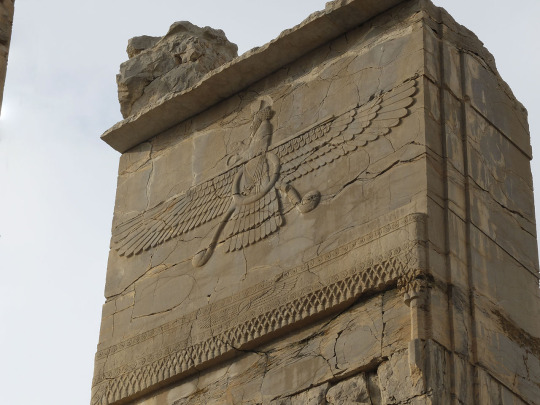




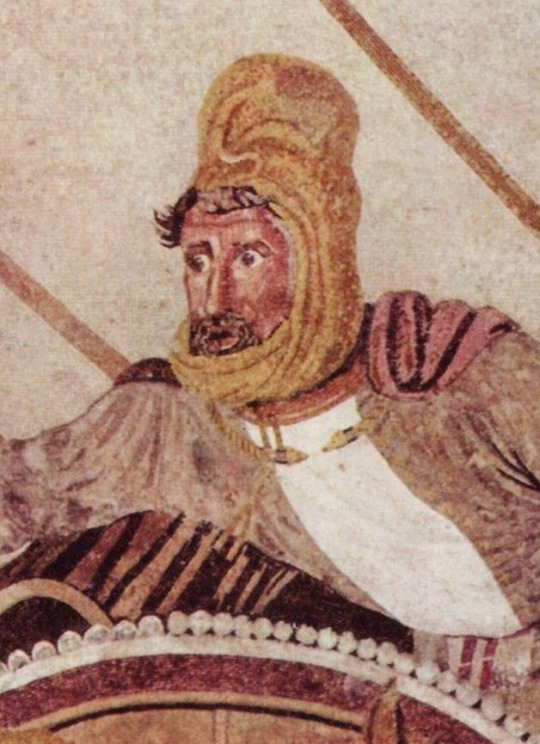
#military history#antiquity#iran#greece#ancient greece#classical greece#ancient ruins#ancient iran#ancient persia#achaemenid#persia#zoroastrianism#alexander the great#cyrus the great#xerxes#artwork#government#history#persian empire#ancient egypt
91 notes
·
View notes
Text
This video made me homesick ?? 😢💓 As a Greek, my culture includes Orthodoxy since it's our ethnoreligion, and suddenly I feel that I have so much in common with so many people around the world!
I was also excited because some of the Christian communities shown here are ancient, and have persisted despite centuries-long prosecutions and pressures! (When talking about the "first" and the "ancient" Christianity we're talking about Orthodoxy or dogmas linked to Orthodoxy.)
I'm referring to the era before the Western European colonization. It was when people came to it freely and what we today call "Catholicism" wasn't what they came into. The Christians in these areas were culturally linked more to the Eastern Roman Empire (Byzantium) and to the Orthodox creed.
Christianity's home is the Middle East. Starting from Jerusalem, it spread to the whole Levant region. Assyrian, Lebanese, Syrian, Jordanian, and Armenian people came to Christianity in large numbers from the 1st century already. Antioch has been a stronghold of Christianity, and a producer of the brightest Orthodox minds.
The West Arabian Peninsula (Hejaz region) held the majority of Christian Arabs. Christians lived around Mecca and Yathrib before the advent of Islam. One of the earliest Christian church buildings ever, known as Jubail Church, is located in Saudi Arabia and it was built around the 4th century.
Christianity in Africa first arrived in Egypt in approximately 50 AD. By the end of the 2nd century it had reached the region around Carthage. In the 4th century, it arrived to modern-day Ethiopia and Eritrea (the Aksumite empire), and the region was one of the first in the world to adopt Christianity as its official religion. The Nubian kingdoms of Nobatia, Makuria and Alodia followed two centuries later. From the late 5th and early 6th century, the region included several Christian Berber kingdoms.
This is the chant, in Arabic (with subs in many languages). There's a Greek version too but on youtube I only found the singing version (lit. "ψαλτοτράγουδο"):
youtube
youtube
#Feel free to search for more denominations in the aforementioned regions bc there's not enough room here to get into the hundreds of details#about each community#And it goes without saying that there are all sorts of Christians in these regions today#not just orthodoxes#orthodoxy#religion#tradition#arabic#christian arabs
44 notes
·
View notes
Note
would you ever visit the middle east?
yes of course haha, not a question that needs to be asked at all. regrettably i do it very sparingly, just bc life tends to be pretty busy over here and i can’t drop everything on whim that often. i visited this summer for the first time in like a decade, but it was a very wonderful experience. getting to reconnect w arabic, w arab cuisine, w relatives… a magical few months that i’m dying to repeat as soon as possible.
i took your ask in good faith, but i’m wondering why you thought there was a chance i wouldn’t visit in the first place.
incidentally, i know the term “middle east” is essentially entrenched in society now. even my arab relatives use it. but i will still probably forever mourn the fact that the middle east is like the only region i know of where it’s referred to literally relative to Europe, whereas places like China India Japan etc get their regional designations independent of Eurocentric geography. it’s not to say that referring to the arabian peninsula as middle eastern is an indication of racism, but something like West Asia would have been more accurate. i can imagine it would make a good impact in the future if we slowly started replacing “middle east” with “west asia” and allowed that region to have its own identity, one that’s separate from a term coined by some british guy too long ago (and which has already accumulated a lot of of unfounded, racist connotations).
#whenever i use the term middle east it’s legit only bc it’s functional.#ppl would be like ??? if i used west asia#but a girl likes to dream#ask
27 notes
·
View notes
Text
Flag of the Kingdom of Mongolia
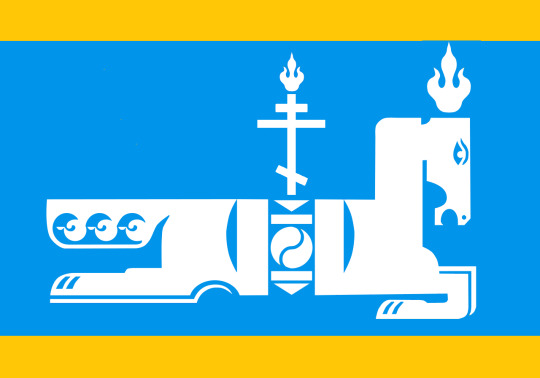
This is the flag of the Kingdom of Mongolia. It comes from a world where China successfully repelled the Mongols early on. As a result, the Mongol Empire never came to be. The Mongols continued to be pushed farther and farther west until they arrived in Eastern Europe. Eventually, they settled around where Romania and southern Poland are in our world. Thus, the Kingdom of Mongolia was born. The Mongols were frequently visited by Byzantine missionaries, and the Mongolian Orthodox Church is the official state religion. The Byzantine Empire also remains a major trading partner for Mongolia. In more peculiar alliances, Mongolia is also a major ally of the tiny mountainous nation of Neo Hellas, the final remnant of pagan Greece.
The coming of the Mongols altered the migration patterns of several other peoples. For example, the Bulgars settled in Russia, establishing the Czardom of Bulgaria. Meanwhile, several Germanic tribes invaded Greece, and Byzantium is currently ruled by a Germanic dynasty. Islam was still founded, but it never expanded beyond the Arabian Peninsula.
In terms of bad relations, Mongolia has always had a very tense relationship with the Franco-Saxon Kingdom. Throughout the years the Franco-Saxons have repeatedly attempted to conquer the Mongolians. Even after all these years, Mongolia remains bitter about the Franco-Saxon invasion that occurred during the Second Great Patriotic War. Despite this, in more recent times there has been increasing emphasis on moving on and letting go of the past. Younger generations in particular are more likely to support reconciliation between the two nations.
Mongolia takes pride in its dual mature of East Asian heritage and Eastern European culture. The flag reflects this dual heritage. The blue recalls both the cloak of the Virgin Mary and the eternal blue sky of the Tengrism. The horse symbolizes the nomadic past of the Mongolian people, before they settled in Eastern Europe. The cross represents the Mongolian Orthodox Church, with the flame representing the flames of Pentecost. The interlocking circles halves represent the dual nature of the Mongolian people. The golden bands represent the hope that the Mongolian people will always prosper no matter what life throws at them. They also help to offset the blue on the main body of the flag.
https://drakoniandgriffalco.blogspot.com/2019/03/flag-of-kingdom-of-mongolia.html?m=0
#alternate history#alternate history flag#alternate history flags#vexillology#flag#flags#mongolia#Kingdom of Mongolia#Flag of the Kingdom of Mongolia#Romania#Poland#ukraine#moldova#eastern europe#Mongols#alt history
36 notes
·
View notes
Text
yasmina fadoula’s ethnicity is such a haunting question. her VA is pakistani. the fandom wiki labels her as the first “middle eastern” character. colin trevorrow interacted with a post calling her west asian. fadoula isn’t even a real last name. “fadoul” or “fadol” would be the closest and both of those are more prevalent in north africa actually BUT do have some presence in the arabian peninsula and south asia. “yasmina” is one of the most generic muslim names you can have and has no real indication of region. the only reference to her culture is kebabs which is also completely non-culture specific. we don’t know her mom’s name to guess there. south asians, west asians, and north africans can all look like her and her mom. the closest we can really guess is maybe pakistani-arab??
#jurassic world#yasmina fadoula#this is how western media treats brown ppl in general so like#I’m not mad#but I am curious#my theory is that most people believe arab and desi are the same thing#so they’re like… yeah she’s that#which is why I’ll claim her as both
24 notes
·
View notes
Text
December 3rd, 2023


Violet Dropwing (Trithemis annulata)
Distribution: Found in the majority of Africa, the Middle East, the Arabian peninsula and southern Europe.
Habitat: Most common near freshwater habitats; slow-moving rivers, marshes and still-water ponds. Occasionally found near brackish water and in semi-arid rangelands, where temporary water is present. Mainly inhabits warmer savannah regions.
Diet: Adults and larvae are carnivorous; larvae are aggressive predatos that feed on aquatic invertebrates and tadpoles, while adults feed on other invertebrates.
Description: The violet dropwing's namesake is its behavior of lowering its wings when perching. This species is common and widespread due to its sheer adaptability; while these dragonflies do require a source of freshwater to breed, larvae have been known to inhabit temporary water sources. Larvae can develop very rapidly, and as such, this species can take advantage of the rapidly-shifting conditions in semi-arid habitats. Due to their sheer adaptability, violet dropwings have expanded their range to the north and west since the 1990s, having recently become established in parts of France and eastern Spain.
(Images by Gail Hampshire (male) and Bernard Dupont (female))
15 notes
·
View notes
Text

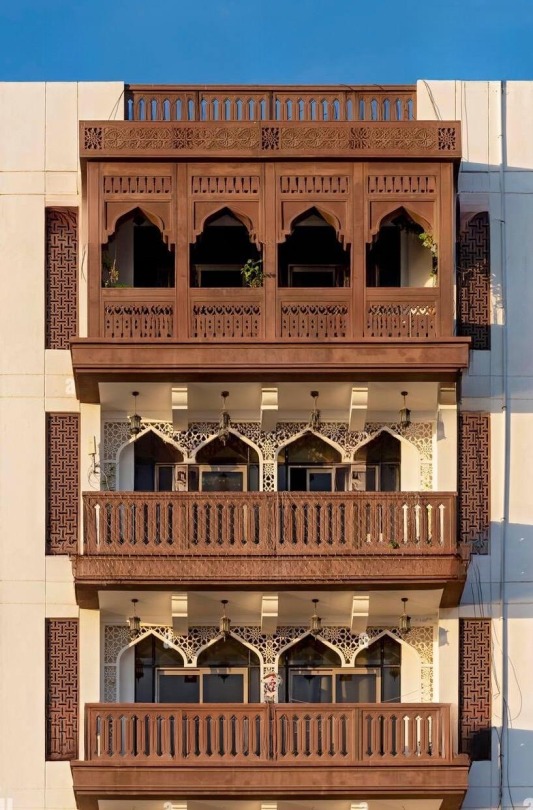
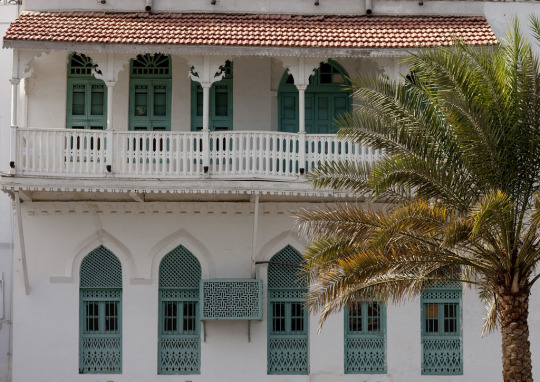
Muscat | مسقط
Traditional merchant houses in Muscat, Oman. 🇴🇲
#arab#arabian#culture#middle east#architecture#Oman#sultanate of oman#عمان#🇴🇲#سلطنة عمان#Muscat#مسقط#old architecture#arab architecture#arabian architecture#arabian peninsula#Arabian Gulf#east Arabia#eastern Arabia#houses#traditional architecture#history#ethnic#West Asia#MENA#arabia#Khaleeji#الخليج#الخليج العربي
6 notes
·
View notes
Text
The Semitic term goes back to Sam, son of Prophet Noah, peace be upon him - This term was used in regards to a group of peoples who lived in the Middle East, specifically in the Levant, the Arabian Peninsula, and Mesopotamia. This name does not indicate that the Semites are a combined nation with one state and one common entity.
But what unites these peoples is their closeness in language, as it can be said that these peoples once had one language, and many dialects branched out from it. Then these dialects developed with time, turning into languages, and these multiple languages remained sharing one linguistic features.
I don’t want anyone to call arabs/middle easterns anti-semitic, when they themselves are semitic.
The anti-semitic concept has been used to counter argue with pro palestine supporters especially middle easterns and arabs.
It’s very invalid given the origin of the word. People who call arabs / middle easterns anti-semitic are nothing but ignorant and uneducated.
#free palestine#palestine#gaza#israel#genocide#فلسطين#free the palestinians#from the river to the sea palestine will be free#غزة#barbarism#semitism#semitic#muslims and christians are semitic too
9 notes
·
View notes
Text
Me: (looks at leaks) Okay, new characters! Can't wait for their storylines . . .
Genshin Twitter: WHY ARE THEY WHITE-PASSING AND PALE AND STEREOTYPICAL AAAAAAAAAAAAA-
Me: (looks at my roots and being a historical nut) (cracks knuckles)

In what may be one of my most controversial posts yet, I attempt to explain and process what the hell is up with the Sumeru leaks.
I do not expect to not be clowned for this.
Folks, you kinda jumped the gun on this one. Seriously. I have a few points to make on this and it may not be liked, but as a history enthusiast and someone who loves to learn, I have to clarify some things.
If I do get some things wrong, feel free to correct me on them! That's kind of the point here. I'm always ready to learn some more.
1.) Sumeru is somewhat based on the Abbasid Empire.
If people bothered to look at the content we've received about Sumeru so far and actually pay attention, you will be able to tell that there are Indian, Persian, and South Asian elements to the region as well as Middle Eastern. This is shown in the little bits of information that you can find here.
And if one looks at the reaches of Islamic empires throughout history, it will show that at some point, these elements have mixed, matched, or have come into contact with each other during the Islamic Age.
The picture below represents the reach of the Islamic Empire during its initial run from 622-750 CE under the Umayyads along with the Islamic Golden Age under the Abbasids.

The regions that are shown here include Egypt, Persia, the Arabian Peninsula, Northern Africa, Central Asia, India, Turkey, Iberia, and Central Asia, but they do not do justice to the spread of their culture and Islam at the same time periods.
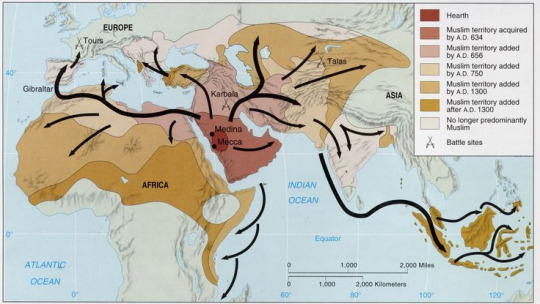
(Please note that while the empires did not reach these areas the places shown were heavily influenced by Islamic culture and religion, thus forth making them majority Muslim at the time.)
And as you can see, South Asia is right there.
Now look at these maps compared to a modern map of the same areas and tell me with a straight face that this region wasn't diverse enough to hold multiple cultures besides Egyptian and Arabic.
This would not only explain the different regions featured in Sumeru concerning the characters but also why they may or may not look different and dress as such. I'll go into the really gritty bits about the dress later.
2.) The Baghdad House of Wisdom definitively inspired the Dendro Archon's basis as the Archon of Wisdom and Sumeru Academia
This point speaks for itself, but just to be sure people get it, the Baghdad House of Wisdom was considered the height of knowledge and intellect for centuries during the Islamic Golden age.
As the crown jewel of the capital of the Abbasid Empire, every nation in the known world and their rivals wanted a piece of what was in that place! We got math, language, science, stories, art, music, and all sorts of stuff from them. In fact, we have them to thank for preserving a good chunk of human knowledge, even with its destruction in 1258 by the Mongols.
Now, wisdom is typically defined as the application of knowledge and intellect combined with practical experience, which Sumeru may or may not have a lack of at the moment if Lisa brings this point up once or twice with the state of Sumeru's intellectual elite. This may or may not be the hinting of inspiration from the Abbasid Empire's decline due to bureaucratic corruption, heavy taxes, social strife, civil war, and the impending Mongol invasion.
With this, it's no mistake that Sumeru Academia and the area surrounding it sounds a hell of a lot like that intellectual haven and that it may or may not serve as a tragic future plot point.
3.) Dori's design does take some checkmarks for orientalism, but for less reasons than you think.
Yeah, you guys need to look at this first. You need fresh eyes.

First of all, I'm going to tell you to completely banish Disney's Aladdin from your mind. It holds no bearing on what I'm about to say. None. It's a cheap copy. Don't even process it, because I'm going to bring up the real inspiration of One Thousand and One Nights.
Contrary to popular belief, the stories contained in One Thousand and One Nights is not based in just the Middle East. There's actually a lot of it based in Persia and Mesopotamia as well as in India, South Asia, and some of China.
If the time period of this is to be believed (the book itself was published around the same Islamic Golden Age I keep bringing up), the style of dress was vastly different from what people think, and speaking of their style of dress, I'd like to introduce you all to something called the shalwar kameez.

The shalwar kameez is popular in Central and South Asia (Pakistan, India, Afghanistan) and As you can see, the bagginess of the bottom is very accurate, and given the established fact of Sumeru's basis, this dress has some historical basis and concrete reasons for it to exist.
Now, let's talk about the lamp. There is real basis for this to be a thing, but I need to clarify some things first. This lamp is based on an oil lamp and to be fair, the basic design for it being made of metal and its look stay true to its purpose and sticks to the regions discussed here. Bronze oil lamps of this look were definitely around.
Now I will briefly touch on the djinn. Djinn are classified as beings of elemental energy and naturally inclined to pranks, harmful or playful as well as possessing an unholy amount of power and knowledge. Djinn in Islamic canon have been known possess people, produce offspring with them, and be described as a force of good or evil.
In the tales within the One Nights, however, they are typically trapped in small objects, typically a ring or a lamp. The rubbing of either of those things can summon them out. In the tale "The Fishermen and the Jinni", the jinni (djinn) is the one to grant the fishermen three wishes, while in the tale "Aladdin and the Wonderful Lamp", Aladdin acquires a djinn in a ring and a more powerful one in an oil lamp.
So the djinn in the lamp at its basis is not stereotypical at all as the idea of having an all-powerful being trapped by something relatively insignificant to its existence is common enough.
However, the overarching cry of what I believe the rest of the design is based on is something that I can see wholeheartedly. The 'dancer girl' top does not mesh at all with the time period described in detail and does indeed give to the stereotypical orientalism. This video goes more into length on that here.
So yes, there is issue with the dress and inspiration behind it, but it was not the egregious crime it was made out to be.
4.) I am personally terrified that appearances have such large precedence over personality with people in this fanbase.
We haven't met them. We don't know them. We have no idea what they're really like at all. And yet, despite this fact, everyone loses their shit once they aren't what they envisioned them to be based on what they look like. Even if they are pale as hell, why does it matter so much? Do I wish that they could consider that? Sure! Will it cripple my enjoyment? No!
As someone quite dark-skinned myself who has suffered constant mischaracterization and bullying at the hands of literally everyone around me for acting certain ways while looking the way I do, I find it puzzling and concerning that people are so quick to write people off because of the color of their skin as the very same thing has happened to me.
As a result, this point has to be made as controversial as it has become:
Culture does not equal looks and there is no difference between discriminating against skin colors because the basis of it is the same.
Let that sink in for a second.
People really call themselves 'not racist' and 'educated' and then they pull this kind of heinous shit in public discourse and pretend that it's completely okay because they looked white.
And I guarantee you that if they were dark-skinned, people would still call it racist for being 'the stereotype'. I've seen it happen and it will likely happen again. You can't please anyone anymore.
----
So those are my thoughts on the leaks and everyone's reactions to them. Feel free to agree, disagree, or do something in between because I don't care anymore. I'm tired of skin color determining everything here. It exhausts me.
Take the L and go.
154 notes
·
View notes
Text
Justification for the Crusades
Justification for the Crusades
“Exo 6:2 And God spoke unto Moses, and said unto him, I am Jehovah:
Exo 6:3 and I appeared unto Abraham, unto Isaac, and unto Jacob, as God Almighty; but by my name Jehovah I was not known to them.
Exo 6:4 And I have also established my covenant with them, to give them the land of Canaan, the land of their sojourning’s, wherein they sojourned.”
I believe I needed to start here. God, Yahweh reveals himself to Moses in a different manner than Abraham, Issac, and Jacob. He reminds Moses of the covenant he made with them, and he reveals for the first time His Lordship and the Authority of His name. Christians now know the power in the name of Jesus. God is setting the stage to deliver His people out of slavery, and into this “Promised Land.”
Soon after God delivered them out of slavery Amalek attacked them in the wilderness. Exodus 17:8-16 gives us the account of this pivotal event because that ends with the LORD swearing to have War with Amalek from generation to generation.
If we back up to Exodus 15 we read about “The Song of Moses” where Israel sings the words “The Lord (Yahweh) is a man of War: the Lord (Yahweh) is his name” The Old Testament, from this point forward is full of great battles, from Jericho to Gideon's campaign, to The siege of Jebus, which essentially was David leading the Israelites to take Jerusalem. We know, without a doubt that Israel is called to war by God, the question then is, are Christians under the new covenant called to War?
When people say that Christians are just as violent as Islam, and then use the Crusades as the main example, they make a great point. I am sure the Crusaders were ruthless and savage, nothing even resembling our Lord and Savior Jesus Christ, but anyone who has been in war will tell you “War is Hell”
So where does the Christian Justification come in? The Kingdom of Heaven is not exclusive to Jerusalem. “We know we do not wrestle against flesh and blood but principalities and dark forces” (Eph 6:12) We know that defending our families and loved ones with our lives is justified, but should Christians be “Militarized” if so, for what? This is the real question. Islam organized a military after centuries of battling the Roman Empire, eventually becoming the Eastern Holy Roman Empire.
Rome never conquered the peninsula of Arabia. They seized enough land in modern Kuwait to establish trade routes, but the regions hosting Mecca and modern-day Riyadh were never conquered.
When Muhammed began his teachings in 613 A.D. it was not in a region conquered by the Roman Empire. It was 300 years after Constantine made Christianity the official religion of the Roman Empire. Though Rome had footholds, it had never truly conquered the lands and its people.
The Arabian Peninsula was also home to the descendants of the tribes and nations fighting against Israel for well over millennia. Jericho was conquered in 1400 B.C. which would indicate two full MILLENIA'S before Muhammed. The roots of animosity and justification had to run so deep.
I have not studied the Quran so I do not know Muhammed's justification for Islam to lay siege to Jerusalem (636-637), nor do I know what the catalyst for their conquest of North Africa and eventually into Europe was. One thing was made clear...Islam had declared war on not just the descendants of Moses, and not just the Byzantine Empire, but on all of Christianity.
Once Christianity brought the Crusades the pride in the hearts of man had justified their means. Nobody was innocent anymore, nobody was right.
Even though I acknowledge any Christian excuse for War as hypocritical, I do believe that war is inevitable in the preparation of the Bride. Christians have been tasked with spreading the good news, the Apostles died as Martyrs for this Good news, the early church was persecuted for this good news and Christianity thrived.
Is this what it means? For us to all be Martyrs? To not be lovers of violence? That if we live by the sword, we will die by the sword? Are followers of Christ destined to be slaughtered as the Lamb himself? Is this the depths of laying down one's life? Did Christ die that we might die, or that we may have Life? Is Life worth fighting for?
Christ does not want His Men to be weak, nor allow crimes perpetrated upon their families! To allow our mothers and daughters to be conquered and raped? Enslaved? Jesus would never stand by and allow this.
Since I do believe that violence is to be met with violence, to defend against violence perpetrated upon my family, I believe one must Establish boundaries and borders. Borders that infer "This is where I draw the line" “This is mine, and I will defend this to my last breath to protect it.”
If you do not, dark forces will try to stamp you out. Hitler tried very very hard to exterminate all that was Jewish. The world will always create an enemy of God's people. Socialism, Communism, Nazism, Islam, Satanism, Witchcraft. The enemy has even turned Christianity against Christianity. From the great schism to the protestant reformation. Protestant Americans in southern U.S. states killed Jewish students from the northern states because they hated them. Northern and Southern Ireland had a Civil War with Protestants backing the Queen's rule in the North and Catholics fighting for independence in the South.
As I establish My boundaries in life, perhaps I seek out others to collectively protect our beliefs and families. To keep them safe from wolves, and roaring lions that look around seeking to devour. Perhaps this fellowship of creating borders, and boundaries causes us to form a community, or perhaps a tribe. Perhaps we reach out to other tribes to collectively further our boundaries because of strength in numbers, perhaps we create a nation or Kingdom. If the American media has taught us anything in the last four years, it's that not having borders will allow chaos and enemies inside your homes.
Now, applying this reasoning to our Christian morality, we will eventually come full circle to "Where" exactly we believe we should establish our boundaries. Is Christianity exclusive to Europe and The U.S.A.? Is Catholicism exclusive only to Italy? Is the Orthodox church exclusive only to Russia? Are all the different denominations simply trying to establish their foothold in regions? If so, then so is Islam, Hinduism, and Buddhism.
Do I believe in Israel or Christianity maintaining the boundary and authority over Jerusalem?
Yes...
I unapologetically confirm that I stand with Israel, especially since I was raised by a long line of American veterans to never forget the past. I was shown the footage of Auschwitz, and Dachau. I remember the black-and-white footage of Jews standing in lines being marched into showers, and ovens. I will never stand before my God and say I did nothing to prevent that from happening...again.
“God hates a Coward.” "Rak Chazak Amats"
Israel's God is my Lord and savior's Father, but I believe in the Trinity, so their God is my God even if they look down on us for believing that Jesus is the Christ. Even if they are not saved due to their denial of Jesus, I will support them.
I believe the Crusades are justified... because I believe Israel should always have a home.
Mat 10:34 “Think not that I have come to send peace on earth: I came not to send peace, but a sword”.
Ecclesiastes 3:8 “A time to love, and a time to hate; a time of war, and a time of peace.”
Until Christ comes again, I believe we are stuck in this age of Warfare. The only way to world peace is in Christ.
#bible#god#jesus#healing#us politics#donald trump#ai art#jesus christ#christ is king#easter#catholic#christianity#good friday
5 notes
·
View notes
Text
Dilmun (Telmun) was a civilization located in the eastern part of the Arabian Peninsula. Although this was quite an old civilization, it is much less famous than the four cradles of civilization of the Old World, i.e. Mesopotamia, Ancient Egypt, the Indus Valley Civilization, and the Yellow River Civilization.
30 notes
·
View notes
Text
Mystic Messenger x Middle Eastern Reader
Basically POV youre Middle Eastern and the little things that add to the relationship
Characters; Jumin Han, V, 707
A/N: you might be thinking, dami, why are you writing for a dead fandom about something nobody asked for? And i assure you. Impulse overtakes me on a daily basis. Also I feel the need to add that I am Middle Eastern
(Gender neutral reader as per the usual!)
V
When he first saw you, he thought you were beautiful
Because of his nature, he really wanted to photograph you in warm sunlight. He felt the best way to remember you was by taking as many photos as he could
When you told him where you were from, he thought it was pretty cool, and always likes to ask about your cultures and traditions.
I like to think he wants to try your country’s cuisine, and he’ll definitely like it. Probably buys a cookbook so he can learn your favourite desserts and foods, and he thinks its a great way to learn more about you.
Since he travels abroad often, if you’re comfortable, he’d love to visit your hometown, and possibly your parents as well.
Oh my god he would be so so good to your parents
He’s respectful, greets them at the door, brings his own food to give to them
You know because he’s loaded he can basically buy expensive ass gifts for your family if they’re more traditional
So so sweet. Helps you do housework at your parents’ home, all of that.
He honestly wants to learn how to speak modern Arabic, or your Arabic slang as well.
It’s just he doesn’t know where to start.
Like? How do all the different pronouns work? Why are there so many words for so many different specific things?
Pls help him
Oh yeah he definitely messes up by saying some slang word that means something entirely inappropriate given the context. Watch him call a cat a bra bc he doesn’t know the difference
Calls you habibi/habibti (my love) or hayati (my life) because its the only words he kind of knows the meaning of
Overall really sweet like he always is. Practically the best boyfriend ever. Unmatched
Jumin Han
Oh you have nothing to worry about at all
The worlds most civilised polite businessman with manners that are just perfect for meeting your parents with
He’s already travelled half the Arabian peninsula I’m 90% sure he knows the language too
Super sophisticated, super sweet
If you like any particular food he hires a full fledged 3 Michelin star ass restaurant chef for any dish you’d like
Oh you want some kubba or smn? Say no more in the next few hours you’re eating the best kubba in your life ok
Idc if you don’t like kubba the 3 Michelin star ass chef is gonna make you like it I swear
Has probably already been to where you live at least twice but he’ll go again just for you
He finds you absolutely gorgeous like have you seen yourself you’re gorgeous
Likes to trace your face and cheeks with his knuckles and tells you you’re absolutely beautiful
Can probably get any outfit tailored perfectly to you the moment you mention your specific traditional clothing
Again your parents cant refuse. He’s literally a corporate executive of the highest ranking business where he is. He has so much money he’ll only ever get richer. Dowry money? Oh yeah that costs just about an eighth of his weekly salary let’s double the dowry
You feel v v v loved. Unmatched husband material
707
He knows Arabic
Was a bit shocked when you had zero issue getting into his house bc u know the language enough to say cat in Arabic
But he also sort of knew so he changed the entire algorithm of his lock system to be in Tagalog just to be safe
Vanderwood has held a grudge since then
You know how he is he’s totally got every random nuanced joke memorised and prepared up his sleeve so if you swear in your language slang ever he probably knows what it means and will definitely snicker even if you don’t realize it
Honestly nothing much changes he just knows already lmfao
#this was so fun to write i couldn't help myself#I’ve been craving this kind of fic for decades and so I did it myself#very self indulgent#when will I get a boyfriend who cares about learning my culture#mystic messenger#jumin han#v#jihyun kim#mystic messenger 707#mystic messenger headcannons#jumin han x reader#jumin han x gn reader#v x gn reader#v x reader#jihyun Kim x reader#jihyun kim x gn reader#middle eastern reader#707 x reader#saeyoung choi x reader#gn Reader#mysme jumin han#mysme V#mystic messenger v
109 notes
·
View notes